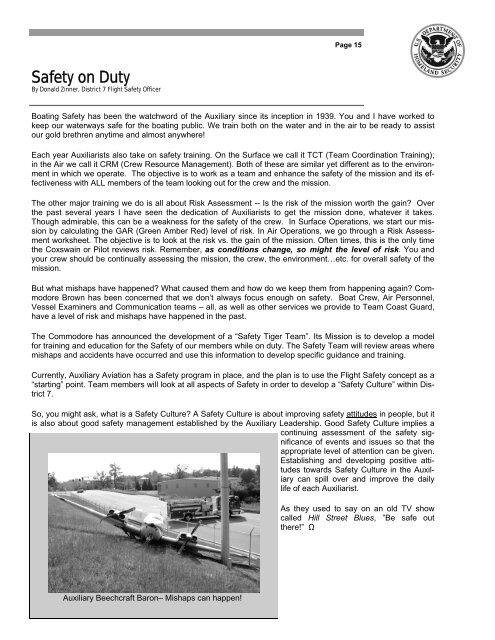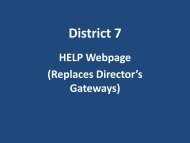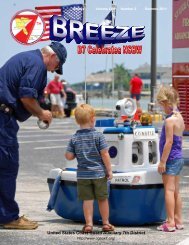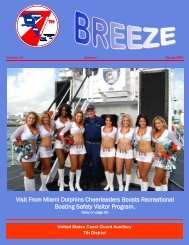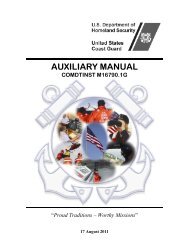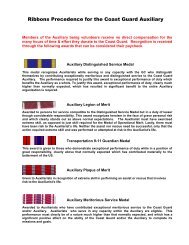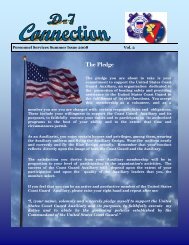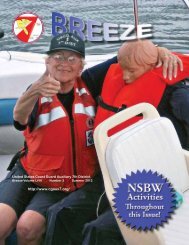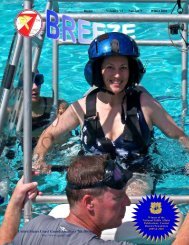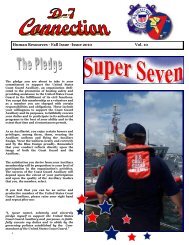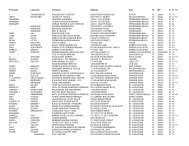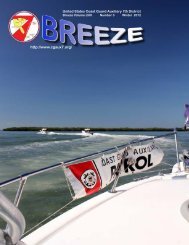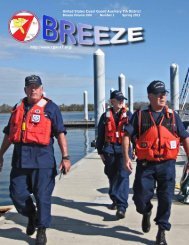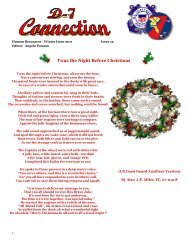Division Eleven Wins International ISAR ... - USCGAUX District 7
Division Eleven Wins International ISAR ... - USCGAUX District 7
Division Eleven Wins International ISAR ... - USCGAUX District 7
Create successful ePaper yourself
Turn your PDF publications into a flip-book with our unique Google optimized e-Paper software.
Safety on Duty<br />
By Donald Zinner, <strong>District</strong> 7 Flight Safety Officer<br />
Page 15<br />
Boating Safety has been the watchword of the Auxiliary since its inception in 1939. You and I have worked to<br />
keep our waterways safe for the boating public. We train both on the water and in the air to be ready to assist<br />
our gold brethren anytime and almost anywhere!<br />
Each year Auxiliarists also take on safety training. On the Surface we call it TCT (Team Coordination Training);<br />
in the Air we call it CRM (Crew Resource Management). Both of these are similar yet different as to the environment<br />
in which we operate. The objective is to work as a team and enhance the safety of the mission and its effectiveness<br />
with ALL members of the team looking out for the crew and the mission.<br />
The other major training we do is all about Risk Assessment -- Is the risk of the mission worth the gain? Over<br />
the past several years I have seen the dedication of Auxiliarists to get the mission done, whatever it takes.<br />
Though admirable, this can be a weakness for the safety of the crew. In Surface Operations, we start our mission<br />
by calculating the GAR (Green Amber Red) level of risk. In Air Operations, we go through a Risk Assessment<br />
worksheet. The objective is to look at the risk vs. the gain of the mission. Often times, this is the only time<br />
the Coxswain or Pilot reviews risk. Remember, as conditions change, so might the level of risk. You and<br />
your crew should be continually assessing the mission, the crew, the environment…etc. for overall safety of the<br />
mission.<br />
But what mishaps have happened? What caused them and how do we keep them from happening again? Commodore<br />
Brown has been concerned that we don’t always focus enough on safety. Boat Crew, Air Personnel,<br />
Vessel Examiners and Communication teams – all, as well as other services we provide to Team Coast Guard,<br />
have a level of risk and mishaps have happened in the past.<br />
The Commodore has announced the development of a “Safety Tiger Team”. Its Mission is to develop a model<br />
for training and education for the Safety of our members while on duty. The Safety Team will review areas where<br />
mishaps and accidents have occurred and use this information to develop specific guidance and training.<br />
Currently, Auxiliary Aviation has a Safety program in place, and the plan is to use the Flight Safety concept as a<br />
“starting” point. Team members will look at all aspects of Safety in order to develop a “Safety Culture” within <strong>District</strong><br />
7.<br />
So, you might ask, what is a Safety Culture? A Safety Culture is about improving safety attitudes in people, but it<br />
is also about good safety management established by the Auxiliary Leadership. Good Safety Culture implies a<br />
continuing assessment of the safety significance<br />
of events and issues so that the<br />
appropriate level of attention can be given.<br />
Establishing and developing positive attitudes<br />
towards Safety Culture in the Auxiliary<br />
can spill over and improve the daily<br />
life of each Auxiliarist.<br />
Auxiliary Beechcraft Baron– Mishaps can happen!<br />
As they used to say on an old TV show<br />
called Hill Street Blues, ”Be safe out<br />
there!” Ω


